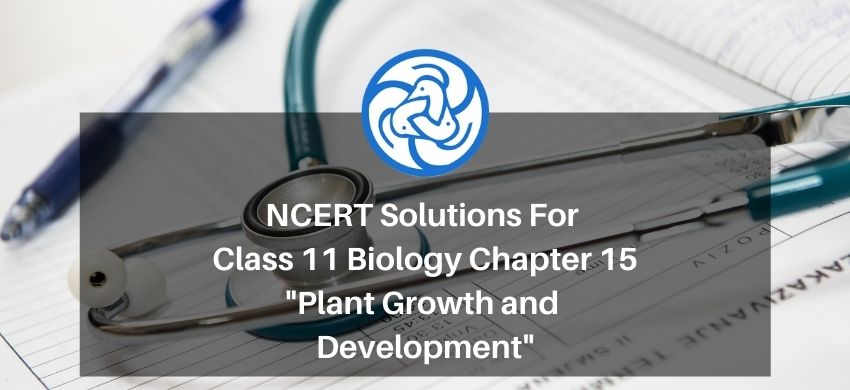
NCERT Solutions for Class 11 Biology chapter 15 Plant Growth and Development PDF
Hey, are you a class 11 student and looking for ways to download NCERT Solutions for Class 11 Biology chapter 15 Plant Growth and Development PDF ? If yes. Then read this post till the end.In this article, we have listed NCERT Solutions for Class 11 Biology chapter 15 Plant Growth and Development in PDF that are prepared by Kota’s top Doctor’s Faculties by keeping Simplicity in mind.
If you want to learn and understand class 11 Biology chapter 15 "Plant Growth and Development" in an easy way then you can use these solutions PDF.
NCERT Solutions helps students to Practice important concepts of subjects easily. Class 11 Biology solutions provide detailed explanations of all the NCERT questions that students can use to clear their doubts instantly.
If you want to score high in your class 11 Biology Exam then it is very important for you to have a good knowledge of all the important topics, so to learn and practice those topics you can use eSaral NCERT Solutions.
In this article, we have listed NCERT Solutions for Class 11 Biology chapter 15 Plant Growth and Development PDF that you can download to start your preparations anytime.
So, without wasting more time Let’s start.
Download NCERT Solutions for Class 11 Biology chapter 15 Plant Growth and Development PDF
Question 1. Define growth, differentiation, development, dedifferentiation, redifferentiation, determinate growth, meristem, and growth rate.
Solution: 1. Growth: Growth is referred as an irreversible, permanent increase in size of an organ or its parts or even of an individual cell.
2. Differentiation: Differentiation is a process in which cells undergo maturation to perform specific functions is referred to as differentiation.
Example: Meristematic cells matures to permanent cells such as xylem and phloem.
3.Development: Development is a process in which the changes occur in the organism in his entire life.
Example: Formation of entire plant through seeds.
4. Dedifferentiation: Dedifferentiation is a process in which the cells have lost the capacity to divide can regain the capacity of division under certain conditions.
For Example: Formation of meristems - interfascicular cambium and cork cambium from fully differentiated parenchyma cells.
5. Redifferentiation: Redifferentiation is a process in which certain tissues that were once able to divide and produce cells again lose the capacity to divide but are mature to perform specific functions.
6. Determinate growth: When the growth of the plant is terminated at a certain point, and maturation starts that condition is refer to as the determinate growth.
7. Meristem: Meristems are the regions in the plant cells through which it divides continuously throughout their life. These cells become permanent and looses the capacity to divide.
8. Growth Rate: Increase in growth of the plant per unit time is referred to as growth rate.
Question 2. Why is not any one parameter good enough to demonstrate growth throughout the life of a flowering plant?
Solution. Growth occurs when there is increase in the amount of the protoplasm. During the growth periods there are several parameters which are involved, such as increase in weight, area, length, volume, and number of the plant part. Hence if only one parameter is considered, it will not be enough for determining the growth of the plant.
Question 3. Describe briefly:
(a) Arithmetic growth
(b) Geometric growth
(c) Sigmoid growth curve
(d) Absolute and relative growth rate
Solution: (a) Arithmetic growth:
-In mitotic division, when one of the daughter cells continues to divide while the other daughter cell undergoes maturation is reffered to as the arithmetic growth.(1 marks) Example: Elongation of roots at the constant rate.
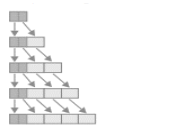
Diagram showing geometric growth (1 marks) Mathematical expression of Arithmetic growth is: (1 marks)
$\mathrm{Lt}=\mathrm{L}_{0}+\mathrm{rt}$ where,
Lt = Length at time " $\mathrm{t}$ "
$\mathrm{L}_{0}=$ Length at time "zero"$\mathrm{L}_{0}=$ Length at time "zero"
$\mathrm{r}=$ growth rate/elongation per unit time
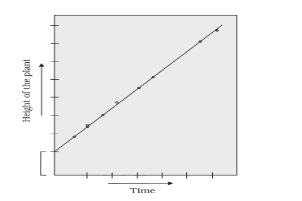
(b) Geometric growth:
- Geometric growth refers to the growth in which initial growth is slow (lag phase), and it increases rapidly thereafter - at an exponential rate (log or exponential phase).
-In this type of growth, both the daughter cells undergo mitotic division.
Mathematical expression for the exponential growth is expressed as:
W1 = Wo ert
W1 = final size (weight, height, number etc.)
WO = initial size at the beginning of the period
$\mathrm{r}=$ growth rate
$\mathrm{t}=$ time of growth
$e$ = base of natural logarithms Here, $r$ is the relative growth rate and is also the measure of the ability of the plant to produce new plant material, referred to as efficiency index.
Hence, the final size of W1 depends on the initial size, Wo.
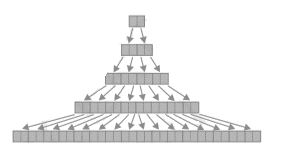
Diagram showing geometric growth
(c) Sigmoid growth curve:
-When growth is plotted against the time, it gives an S shaped curve which is referred to as the sigmoid growth curve. The shape curve due to the slow growth in the log phase, rapid increase in the exponential phase and decline in the senescence phase.
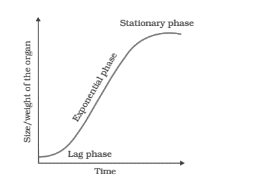
Graph showing sigmoid curve
(d) Absolute and relative growth rates: -Absolute growth rate refers to the growth per unit time.
-Relative growth rates refer to the growth that occurred as compared to the initial period of the growth.
Question 4. List five main groups of natural plant growth regulators. Write a note on discovery, physiological functions and agricultural/horticultural applications of any one of them.
Solution. List of five main natural plant growth regulators are:
1-Auxin
2-Cytokinin
3-Gibberellin
4- Ethylene
5-Absisic acid
Short note on discovery, physiological functions and agricultural/horticultural applications:
Discovery:
Gibberellin was discovered by the scientist E. Kurosawa.
He observed the disease of rice seedling "balcane" which was caused by the fungal pathoger Gibberella fujikuroi. The symptoms appeared when the rice seeds were treated with the fungus. The active substance was isolated and were named as gibberellic acid.
Physiological function:
-They cause the increase in length from the internodes.
-It elongates and improves the shape of the fruit.
-It induces the maturity in the juvenile plants.
-It promotes bolting in rosette plant.
- They help in the delay of senescence. Agricultural application:
-It is applied to the grapes in order to increase the length of grape stalks.
-Application of gibberellins to increase the size of sugar cane stem hence increasing the sugar content.
-It is applied to fruits such as apple to elongate its shape.
-It is sprayed to the crops which increases their length hence increasing its yield.
-It is applied to juvenile conifers to speed up the maturity hence leading to early seed production.
-It is applied to plants such as beet and cabbages to convert the bolting into rosette habit.
Question 5. What do you understand by photoperiodism and vernalization?
Solution. Photoperiodism: Photoperiodism refers to the process of periodic exposure of light to the plants in to induce flowering.
There are three categories of the plant:
Long day Plants: When plants require the exposure to light for a period exceeding a well-define critical duration are referred to as the long day plants.
For example: Spinach, Beet root, radish, etc.
Short day Plants:
When the plants are exposed to light for a less than critical duration before the flowering than the plants are reffered to as short day plant.
For example: Rice, Cotton, tobacco, etc.
Day neutral Plants: When the flowering is independent of the exposure of light, such plants are day neutral plant.
For example: Tomato, Sunflower, pea, etc.
Vernalization: When the flowering is induced qualitatively and quantitatively on the basis of low temperature, that process is referred to as the vernalization.
Question 6. Why is abscisic acid also known as stress hormone?
Solution. Abscisic acid is works during the stress condition for example it regulates abscission during the autumn and dormancy during the spring.
It has of mainly has inhibitory effects on plant growth and development.
The inhibitory role performed by Abscisic acid are:
Inhibiting the seed germination
-Closing of stomata in the epidermis
-Seed development
-Maturation of the plant
-Breaking of seed dormancy
-Helps the seeds to withstand desiccation
Question 7. 'Both growth and differentiation in higher plants are open'. Comment.
Plants consists three types of meristems which includes apical meristem, lateral meristem, and intercalary meristem which divides and contribute to the growth of the plant later the divided cells becomes undergo differentiate to form permanent tissue hence the growth and differentiation in higher plant is open.
Question 8. 'Both a short day plant and a long day plant can produce flower simultaneously in a given place'. Explain.
Solution. In order to induce flowering in short day plants and long day plants at a given place, the plants should be provided the photoperiod according to their requirements.
Short day plants require less amount of light as per their photoperiod for flowering and long day plants require more amount of light for flowering hence they can produce flowers at the same place but the time duration, when they are flowering, will vary.
Question 9. Which one of the plant growth regulators would you use if you are asked to:
(a) induce rooting in a twig
(b) quickly ripen a fruit
(c) delay leaf senescence
(d) induce growth in axillary buds
(e) 'bolt' a rosette plant
(f) induce immediate stomatal closure in leaves
Solution: (a) induce rooting in a twig -Auxin
(b) quickly ripen a fruit -Ethylene
(c) delay leaf senescence-Cytokinin's
(d) induce growth in axillary buds - Cytokinin's
(e) 'bolt' a rosette plant -Gibberellic acid
(f) induce immediate stomatal closure in leaves. -Abscisic acid.
Question 10. Would a defoliated plant respond to photoperiodic cycle? Why?
Solution: - A defoliated plant will not respond to the photoperiodic cycle because leaves are the region which responds to the light and dark durations. It is hypothesized that there is hormonal substance which is responsible for flowering, which is synthesized in the leaves. It migrates from leaves to shoot apices and generates the flowering bud. When the plants with leaves is exposed to the necessary photoperiod, the flowering is induced.
Question 11. What would be expected to happen if:
(a) GA3 is applied to rice seedlings
(b) dividing cells stop differentiating
(c) a rotten fruit gets mixed with unripe fruits
(d) you forget to add cytokinin to the culture medium.
Solution: (a) If there is GA3 application on the rice seedling, then the elongation between the node and internode of the rice plant will take place.
(b) When the dividing cells stops differentiating, then an unorganized mass is formed, which is known as callus.Since the differentiation is absent, then the formation of root and shoot will not take place.
(c) When the rotten fruits are mixed with ripen fruits, then the ethylene gas will be produced, which will hasten the ripening process in unripe fruits.
(d) If cytokinin is not there in the medium then there will not be any growth, differentiation and development of the cell in the culture medium.
Also Read,
Class 11 Chemistry Notes.
Class 11 Biology Book Chapterwise.
Class 11 Biology Exemplar Chapterwise.
If you have any Confusion related to NCERT Solutions for Class 11 Biology chapter 15 Plant Growth and Development PDF then feel free to ask in the comments section down below.
To watch Free Learning Videos on Class 11 Biology by Kota’s top Doctor’s Faculties Install the eSaral App
